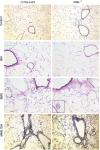Evidence for early fibrosis and increased airway resistance in bone marrow transplant recipient mice deficient in MMP12
- PMID: 21784967
- PMCID: PMC3191761
- DOI: 10.1152/ajplung.00383.2009
Evidence for early fibrosis and increased airway resistance in bone marrow transplant recipient mice deficient in MMP12
Abstract
Idiopathic pneumonia syndrome (IPS) is a significant cause of morbidity and mortality post-bone marrow transplantation (BMT) in humans. In our established murine IPS model in which lethally conditioned recipients are given allogeneic bone marrow and splenocytes, recruitment of host monocytes occurs early post-BMT, followed by donor T cells concomitant with development of severe lung dysfunction. Because matrix metalloproteinase 12 (MMP12) is important for macrophage infiltration and injury in other mouse models of lung disease such as emphysema, lethally conditioned MMP12(-/-) mice were used as allogeneic recipients to determine whether MMP12 plays a similar role in potentiating lung injury in IPS. Surprisingly, MMP12(-/-) mice developed IPS and exhibited an accelerated allogeneic T cell-dependent decrease in compliance compared with wild-type (WT) recipients. MMP12(-/-), but not WT, mice also had allogeneic T cell-dependent elevated lung resistance post-BMT. Recruitment of monocytes and T cells into the lungs was not altered on day 7 post-BMT, but the lungs of MMP12(-/-) recipients had increased collagen deposition, a feature normally not seen in our IPS model. MMP12(-/-) mice had a compensatory increase in MMP2 in the lungs post-BMT, as well as increased β6-integrin compared with WT recipients, and only in the presence of allogeneic T cells. Levels of total transforming growth factor (TGF)-β1 protein in the lungs were elevated compared with WT recipients, consistent with the profibrotic function of β6-integrin as an activator of TGF-β. These data indicate that host-derived MMP12 may be important in limiting development of IPS by allowing proper remodeling of extracellular matrix and effective repair of BMT-related injury.
Figures




Similar articles
-
Acceleration of idiopathic pneumonia syndrome (IPS) in the absence of donor MIP-1 alpha (CCL3) after allogeneic BMT in mice.Blood. 2003 May 1;101(9):3714-21. doi: 10.1182/blood-2002-08-2465. Epub 2003 Jan 2. Blood. 2003. PMID: 12511416
-
The critical early proinflammatory events associated with idiopathic pneumonia syndrome in irradiated murine allogeneic recipients are due to donor T cell infusion and potentiated by cyclophosphamide.J Clin Invest. 1997 Sep 1;100(5):1015-27. doi: 10.1172/JCI119612. J Clin Invest. 1997. PMID: 9276718 Free PMC article.
-
Post-BMT lung injury occurs independently of the expression of CCL2 or its receptor, CCR2, on host cells.Am J Physiol Lung Cell Mol Physiol. 2004 Feb;286(2):L284-92. doi: 10.1152/ajplung.00154.2003. Epub 2003 Oct 3. Am J Physiol Lung Cell Mol Physiol. 2004. PMID: 14527928
-
Idiopathic pneumonia syndrome in mice after allogeneic bone marrow transplantation.Am J Respir Cell Mol Biol. 1998 Feb;18(2):235-42. doi: 10.1165/ajrcmb.18.2.2988. Am J Respir Cell Mol Biol. 1998. PMID: 9476911
-
The Emerging Role of MMP12 in the Oral Environment.Int J Mol Sci. 2023 Feb 28;24(5):4648. doi: 10.3390/ijms24054648. Int J Mol Sci. 2023. PMID: 36902078 Free PMC article. Review.
Cited by
-
Administration of bleomycin via the oropharyngeal aspiration route leads to sustained lung fibrosis in mice and rats as quantified by UTE-MRI and histology.PLoS One. 2013 May 7;8(5):e63432. doi: 10.1371/journal.pone.0063432. Print 2013. PLoS One. 2013. PMID: 23667616 Free PMC article.
-
The history of matrix metalloproteinases: milestones, myths, and misperceptions.Am J Physiol Heart Circ Physiol. 2012 Oct 15;303(8):H919-30. doi: 10.1152/ajpheart.00577.2012. Epub 2012 Aug 17. Am J Physiol Heart Circ Physiol. 2012. PMID: 22904159 Free PMC article. Review.
-
The Versatile Role of Matrix Metalloproteinase for the Diverse Results of Fibrosis Treatment.Molecules. 2019 Nov 19;24(22):4188. doi: 10.3390/molecules24224188. Molecules. 2019. PMID: 31752262 Free PMC article. Review.
-
Mesenchymal-specific deletion of C/EBPβ suppresses pulmonary fibrosis.Am J Pathol. 2012 Jun;180(6):2257-67. doi: 10.1016/j.ajpath.2012.02.010. Epub 2012 Apr 11. Am J Pathol. 2012. PMID: 22503555 Free PMC article.
-
Petroleum coke exposure leads to altered secretome profiles in human lung models.Hum Exp Toxicol. 2018 Nov;37(11):1215-1232. doi: 10.1177/0960327118765326. Epub 2018 Mar 26. Hum Exp Toxicol. 2018. PMID: 29577758 Free PMC article.
References
-
- Anderson BE, McNiff JM, Jain D, Blazar BR, Shlomchik WD, Shlomchik MJ. Distinct roles for donor- and host-derived antigen-presenting cells and costimulatory molecules in murine chronic graft-versus-host disease: requirements depend on target organ. Blood 105: 2227–2234, 2005 - PubMed
-
- Annes JP, Munger JS, Rifkin DB. Making sense of latent TGFbeta activation. J Cell Sci 116: 217–224, 2003 - PubMed
-
- Annes JP, Rifkin DB, Munger JS. The integrin alphaVbeta6 binds and activates latent TGFbeta3. FEBS Lett 511: 65–68, 2002 - PubMed
-
- Birkedal-Hansen H, Moore WG, Bodden MK, Windsor LJ, Birkedal-Hansen B, DeCarlo A, Engler JA. Matrix metalloproteinases: a review. Crit Rev Oral Biol Med 4: 197–250, 1993 - PubMed
-
- Clark JG, Hansen JA, Hertz MI, Parkman R, Jensen L, Peavy HH. NHLBI workshop summary. Idiopathic pneumonia syndrome after bone marrow transplantation. Am Rev Respir Dis 147: 1601–1606, 1993 - PubMed
Publication types
MeSH terms
Substances
Grants and funding
LinkOut - more resources
Full Text Sources
Medical
Molecular Biology Databases
Miscellaneous

